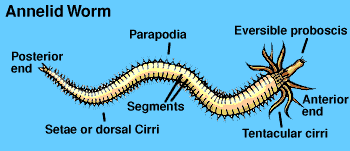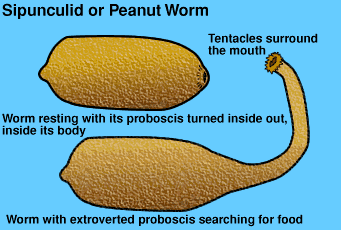|
|
Worms
Marine worms come in many shapes and sizes. In fact there is a tendency to call any animal that is long and thin a worm, but this is a mistake. Many so-called "marine worms" are not really worms at all. It is often quite hard to tell the difference between a beautifully coloured flat marine worm and some of the flattened, shell-less, nudibranch molluscs, which are also beautifully coloured.
Marine worms are grouped into at least ten different phyla, which means that these groups are only distantly related. This is also indicates the great range of worm forms, lifestyles and habitats which occur.
Annelid Worms:
Many marine worms belong to the segmented Annelids, which include the Oligochaetes such as the terrestrial earthworms, the marine Polychaetes such as Eunice aphroditois, and freshwater preferring Hirudinae such as the leeches.
Polychaetes are particularly common on and in muddy and sandy shores. Their most obvious feature are the pairs of parapodia appendages. One pair comes from each body segment. These parapodia are used for crawling and swimming. "Para" means "like", and "podia", "pod" or "ped" means "legs". These parapodia are often tipped with hardened spine-like setae or dorsal cirri.
In some species, such as the Bristle Worm, Eurythoe complanata, these cirri may break off into your fingers and cause a very painful sting. This is because the hollow cirri contain poison. Bristle Worms are also called Fireworms.

Annelid Worm Body Parts:
At the front or anterior end of an Annelid worm is a well developed head which is called a prostomium. It holds two pairs of eyes, three antennea, a pair of palps, pairs of tentacular cirri for testing the environment and sometimes an eversible proboscis or pharynx.
The proboscis is used to capture food. Click here if you would like to see how an Annelid worm feeds.
Sipunculids:
The Sipunculids, or "Peanut Worms", do not have segments, are shaped like a cylinder and are very worm-like. They have a fat flask-like section that grows out into an eversible 'trunk-like" proboscis, with an mouth at the end. "Eversible" means it can turn its feeding proboscis inside out. This is like pushing a finger of a glove inside out.
Sipunculids dig out burrows underneath boulders which lie in mud. They can also bore burrows into soft sand-rock.
Sipunculids feed on organic matter that they extract from sand and mud.

Worm Environments:
Marine worms live under boulders of rocky ocean shores, among the holdfasts of algae, in mud, sandy mud and in sand, while others build tubes in which to shelter.
Marine worms include flatworms, ringed or segmented worms, tube -making worms, burrow-dwelling worms, peanut worms, and ribbon-worms.
Some Annelid Worms:
![]() One
of the most common worms found on rocky ocean shores between the tides,
is the tube-forming Galeolaria,
Galeolaria caespitosa. It is commonly called the "Sydney Coral"
in south-eastern Australia.
One
of the most common worms found on rocky ocean shores between the tides,
is the tube-forming Galeolaria,
Galeolaria caespitosa. It is commonly called the "Sydney Coral"
in south-eastern Australia.
![]() The Fireworm, Eurythoe complanata,
can cause quite a painful wound if you try to pick one up and the
tiny , hard, spikes from the limbs stick into your fingers and break off.
The Fireworm, Eurythoe complanata,
can cause quite a painful wound if you try to pick one up and the
tiny , hard, spikes from the limbs stick into your fingers and break off.
![]() The
Scale Worm, Lepidonotus melanogrammus,
is a short. compact worm with 12 pairs of overlapping scales. each
scale is marked with a distinctive C-shaped brown pattern.
The
Scale Worm, Lepidonotus melanogrammus,
is a short. compact worm with 12 pairs of overlapping scales. each
scale is marked with a distinctive C-shaped brown pattern.
![]() Eunice
aphroditois is a long multi-segmented. robust-bodied predatory
worm and is one of the largest Polychaetes
in the World.
Eunice
aphroditois is a long multi-segmented. robust-bodied predatory
worm and is one of the largest Polychaetes
in the World.
Sipunculid Worm:
![]() The
Peanut Worm, Phascolosoma noduliferum,
has a flask-shaped, almost symmetrical
body, which is pointed at one end. Noduliferum refers to the minute nodules
all over its body which give it a rough surface.
The
Peanut Worm, Phascolosoma noduliferum,
has a flask-shaped, almost symmetrical
body, which is pointed at one end. Noduliferum refers to the minute nodules
all over its body which give it a rough surface.
Eunice
Bristle Worm
Galeolaria
Scale Worm
Peanut Worm
Home
Page
Taxonomy
Biogeography
Rocky Shores
Tidal Levels
Intertidal Zonation
Environmental Factors
Biological
Factors
Feeding Relationships
Activities
Glossary
References
 Life
on Australian Seashores
Life
on Australian Seashores
by Keith Davey (C) 2000
Learning Consultant
- Media
The University of Newcastle
email at australian_seashores@hotmail.com
Scientific Consultant: Phil
Colman
site created 01.01.98 : updated 01.04.2000
